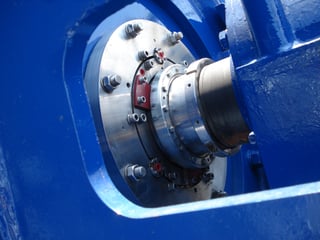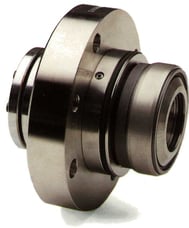
 While many centrifugal slurry pump owners choose expellers or stuffing boxes over mechanical seals, mechanical seals can offer significant savings if maintained correctly. They eliminate the need for gland water that stuffing boxes require, minimizing water consumption and offering significant savings as some don’t require flush water. They also allow pump operators to maintain environmental barriers between the process and the atmosphere, reducing the potential for leaks and drips while offering environmental protection.
While many centrifugal slurry pump owners choose expellers or stuffing boxes over mechanical seals, mechanical seals can offer significant savings if maintained correctly. They eliminate the need for gland water that stuffing boxes require, minimizing water consumption and offering significant savings as some don’t require flush water. They also allow pump operators to maintain environmental barriers between the process and the atmosphere, reducing the potential for leaks and drips while offering environmental protection.
On the other hand, mechanical seals can become limiting factors in any high-head applications. Mechanical seals can’t run dry, so they’re susceptible to air in the pumping system, and they don’t handle solids well. Cavitation is an issue as any kind of impact, excessive vibration, or excessive heat can harm mechanical seals. Seals also require a different kind of shaft sleeve that’s much tighter. If the pump runs dry, elastomers fail, or contamination enters the system, mechanical seals can fail as a result.
Are mechanical seals right for your system?
A few things to consider before choosing mechanical seals include:
- Price — Stuffing boxes are more forgiving and less expensive than mechanical seals. While mechanical seals can range in price from $6,000 to $40,000, stuffing boxes range from $500 to $3,000, depending on shaft size. Expellers can also be more cost-effective than mechanical seals and, since repairing mechanical seals can cost up to 60% of the installation, price is a factor for many.
- Maintenance — “Knowing you have a maintenance crew that understands mechanical seals very well and can maintain them properly is another factor,” said GIW Southern Region Manager and slurry pump expert Angela Bryant.
- Materials — “There’s a lot of variables that go along when you’re selecting a mechanical seal,” Bryant said. “You’ve got to know temperature, if there’s any chemicals that are going through and what kind of chloride in parts per million is involved so you know what elastomers to use with it. You want to make sure any O-rings in a mechanical seal aren't going to fail because of the temperature or pH of the materials.”
In addition, mechanical seals don’t handle large particles well and they’ve got to be chemically compatible with the system, so they’re best for thin slurry applications.
“You don’t want anything that’s going to have heavy solids because if the seal faces should open, solids could penetrate and destroy the faces of the ceramic seals,” Bryant said.
If you’ve chosen to invest in this design for your system, how do you protect it by properly tightening your mechanical seal?
Tightening mechanical seals
 Since this step happens during installation, GIW ships mechanical seals with the tabs in place.
Since this step happens during installation, GIW ships mechanical seals with the tabs in place.
“If installing or replacing a mechanical seal, you’re going to bolt the seal adapter plate to the pedestal, and you’re going to hand-tighten it on,” Bryant explains. “Then, you’re going to locate the seal fit of the adapter of the shaft to make sure it’s centered and everything is concentric. Of course, with mechanical seals, that concentricity has a very close tolerance, much closer than a stuffing box.”
You’ve also got to mount the adapter plate perpendicular to the shaft. Once you’ve got the seal cartridge in, draw it into the adapter on the pedestal evenly by attaching the gland bolts so as not to crack the seal. Check the seal instructions and drawing against the actual parts. Note the location of gaskets and O-rings. Be certain that the locking tabs holding the rotating shaft section of the seal are in place and the fasteners are tight. This keeps the seal faces in contact to prevent damage. Check the fit of the shaft sleeve into the seal bore, and make sure the seal adapter fits into the hub plate or pedestal mounting bore.
Carefully slide the mechanical seal over the shaft sleeve toward the bearing assembly. Do not use any type of tool that could result in impact damage on the seal or any rotating pump part. Move the bearing assembly into position on the pedestal and install the bearing hold-down bolts. Remember that you’ll have to adjust the impeller nose gap later.
 Slide the mechanical seal into position. If it has quench ports, be certain they are aligned correctly. Lubricate the studs with anti-seize and install the washers and nuts. Center the seal on the shaft and torque the fasteners according to seal manufacturer instructions. Clamp the seal to the shaft according to the instruction sheet. The tightening sequence may be circular rather than staggered, and the final torque value is important. Use a torque wrench at the correct torque values.
Slide the mechanical seal into position. If it has quench ports, be certain they are aligned correctly. Lubricate the studs with anti-seize and install the washers and nuts. Center the seal on the shaft and torque the fasteners according to seal manufacturer instructions. Clamp the seal to the shaft according to the instruction sheet. The tightening sequence may be circular rather than staggered, and the final torque value is important. Use a torque wrench at the correct torque values.
Each mechanical seal is equipped with a number of lock tabs to hold the inner section in the proper location during assembly and adjustment. Never rotate the shaft with lock tabs in place. Remove the tabs and store them with their fasteners since they will be required for all future maintenance procedures. If you’re using a quench or lubricating system, install it now.
Then, with the drive coupling or belts disconnected, turn the shaft by hand once to check for free rotation.
To adjust the nose gap, install the lock tabs in the seal and then loosen the shaft clamp. This allows the shaft to move axially. Do not rotate the shaft with the faces locked, or it may damage the O-ring between the seal and shaft sleeve. Loosen the bearing assembly hold-down bolts and move it forward carefully until it just contacts the suction plate. Leave one bolt on the drive end snug to keep the housing from tilting. Tighten the shaft clamp, loosen the lock tabs, and rotate the shaft one full turn to verify that the “high spot” is actually making contact.
Following the torque procedures and values for mechanical seals will insure a tight seal and proper installation.
